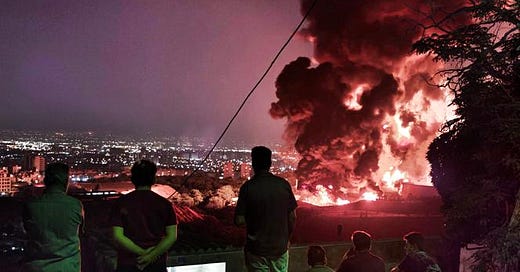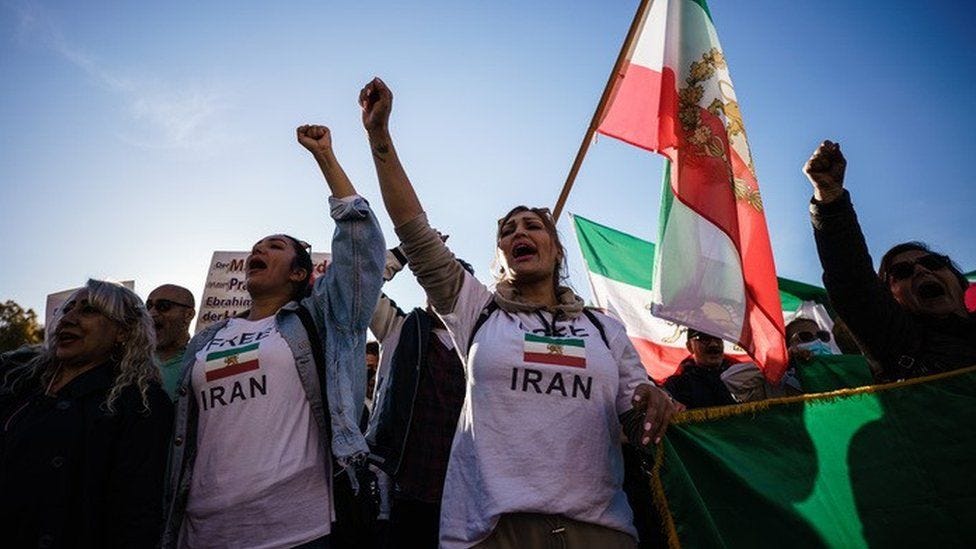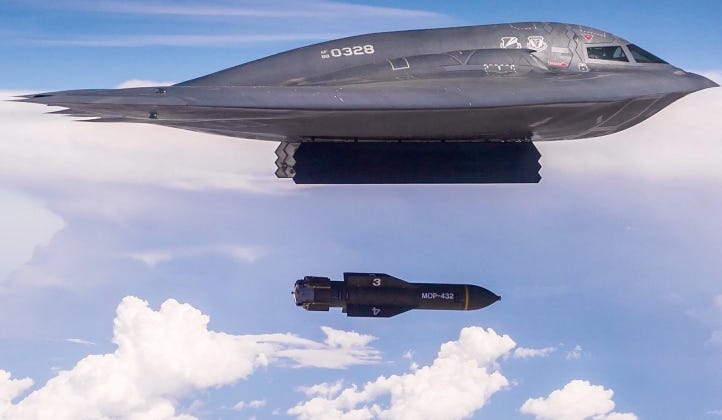Trump's Obama Moment with Iran?
Even before the recent strikes, the Ayatollahs were already on very fragile grounds, especially with their own people. Could the US and Trump end up (literally) burying the regime?
On Friday June 13th, after 60 days of negotiations between the United States and the Islamic Republic of Iran, and in what has been predicted by many for years now, Israel launched a series of major air strikes aimed at military and nuclear installation all over the latter’s territory.
The Israeli Air Force, supported by commando forces and Mossad agents on the ground, reportedly launched over 200 air strikes across Iran on Friday 13th of June. Here in the image in the Shahran oil depot near Tehran.
The stated goal of Israel is clear. To eliminate the threat posed by the ayatollahs. The Islamic Republic is not only the sponsor and backer of proxy forces in the region that directly targeted Israel in the past, such as Hezbollah, the Houthis and Hamas, but also recently failed to meet its nuclear obligations to the IAEA, the global nuclear watchdog, indicating to many that it was only months away from acquiring and testing a nuclear bomb. It has also made major advances in ballistic missile technology, and the ayatollahs have repeatedly said that they would obliterate Israel from the map ever since their establishment in 1979.
The strategy of Iran up until now has been to build out their proxy forces in the region as safeguards against Israeli aggression while they build out their nuclear capabilities. Should Israel have attacked Iran in the past, the latter could have counted on forces like Hezbollah to the north, Syria to the east and Hamas to the southwest to retaliate against Israel on all sides. But of course, since that fateful day on October 7th 2023, the strategic map in the region has changed completely. Hamas have been severely weakened and cut off from their supplies when Israel captured the Philadelphia corridor that borders Egypt in Gaza. The Hezbollah leadership has been decapitated by the movie-like pager surprise attack back in September, along with an estimated 80% of their missile and rocket arsenal. An arsenal that the Islamic Republic spent decades and billions of dollars equivalent building up. The Houthis in Yemen have also been crippled by both American and Israeli strikes and finally, the Assad regime in Syria, a longstanding ally of both Iran and Russia, fell back in November.
Let’s also not forget how unpopular the Islamic Republic is back home. Most Iranians, and all of them under 45, have known nothing else but the ayatollahs and their often repressive attitudes. There have been a number of major protests over the last twenty years, each time involving hundreds of thousands of demonstrators calling for regime change, with each protest growing larger than the last. Protests in both 2019 and 2022 saw huge mobilisation, along with major crackdowns and reportedly hundreds of protestors killed each time. One late 2023 Dutch-based Gamaan Institute study, surveying 158 000 people in Iran and 42 000 in the diaspora, even found that 80% of respondents rejected the Islamic Republic completely, and wished for its complete replacement with a democratic system of government. I wrote about such trends already in a previous article, for which there is a the link here:
Ayatollahs on Life Support
Last night, over 180 hypersonic ballistic missiles were fired from the Islamic Republic of Iran, aimed at targets across Israel. This follows a similar attack back in April. The Supreme Ayatollah Khamenei has said this was in response to the Israeli attacks on Hezbollah in recent weeks, wiping out many of their senior commanders.
Hence the repeated calls by both Benjamin Netanyahu, the Israeli prime minister, and current Crown Prince of Iran and son of the former Shah Reza Pahlavi, for Iranians to rise up and topple the regime. Another revolution in Iran, this time in favour of democratic forces, would of course provide Israel with much needed security guarantees, especially as much of the world’s opinion turns against them due to their ongoing war in Gaza.
However, the regime will not fall so easily. They have a one million man army consisting of both the IRGC and local religious militias like the Basij, the latter’s function being to, officially at least, enforce strict religious laws throughout the country. Unofficially of course, to terrorise and spy upon their own people, keeping any such revolution in check. This army, or at least significant parts of it will have to be neutralised, if the people of Iran are to have any chance at a successful uprising.
In the past, the regime could also count on forces like Hezbollah travelling to Iran to help quell any uprising, like they did in 19 and 22. This doesn’t seem to be happening here. Few people know that Hezbollah, in addition to being a proscribed terrorist organisation by the United States and many other western nations, also has elected officials in Lebanon and often has members within the government there. Well, in recent days, the government of Lebanon, fearing that Hezbollah joining the fight with the Islamic Republic against Israel, told Hezbollah to remain put. Even more surprising, and showing just how vulnerable Hezbollah is right now, Hezbollah accepted, and so will not be helping their former sponsors this time.
Back in November, Israel, taking advantage of the chaos caused by the fall of the Assad regime in Syria, used the opportunity to not only advance their troops into the Golan Heights, going so far as to capture the summit of Mt Hermon which gave them views over Damascus 40 kilometres away, but to also bomb what was left of the Syrian military arsenal, including bases and weapons depots but also, more critically, fighter jets, radar and air-defence missile sites, along with what was essentially the entire Syrian navy. This has allowed Israel to plan news ways to attack Iran, since not only can Israeli fighter jets fly over Syria unimpeded, but can now also have refuelling tankers accompany them over Syria as well. The latter are of course big, slow and easily detectable, and so can only fly over enemy territory once all enemy air forces and air defences have been neutralised.
Now, thanks to this newfound air-to-air refuelling capability, Israel could and did plan new attack runs into Iran itself, and reportedly carried out over 200 strikes around the capital Tehran and other targets throughout the country on the first night alone. Several military and nuclear sites were targeted, along with several senior IRGC commanders and nuclear scientists.
The regime did of course retaliate, as was to be expected. Over one hundred missiles and drones, including hypersonic ballistic missiles, were fired upon the Jewish state, and though the Iron Dome system reportedly intercepted around 93% of all incoming attacks, some missiles did hit targets across Tel Aviv, Haifa and other areas. However, other reports have come in that the Iranian air force and air-defence systems, including Russian S-400 systems, have essentially all been taken out. Many were the first sites targeted by the Israeli attack, with Mossad and Israeli commandos infiltrating the country and unleashing drone swarms to target such sites, in an operation reminiscent of the recent Ukraine Spderweb operation against Russian bombers.
Now, there are even reports that similar air-refuelling tankers, those same slow and easily targeted tankers, now also have free reign over the country, meaning Israel might have achieved complete air superiority over Iran, only in a matter of days. If so, then combined with their satellite and targeting data, the Israeli air force will be hunting down the missile and drone launch sites, detecting the heat plumes from their launch sites. This means that, as time goes by, the Iranian missile force, which was known to be about 2000 strong before they started firing them at Israel back in April 2024, will slowly be eroded over time to the point of impotency. At that point in time, from the Israeli point of view, all that will remain is for the Iranian people to hopefully topple the regime, and so you can be sure that air strikes will continue to hit IRGC and militia targets to help them do so, and to fully neutralise Iran’s nuclear facilities.
However, the latter are often buried deep underground. Israel does possess several “bunker buster” bombs, like the JDAM JBU-31 (1 ton) and JBU-28 bombs (2.2 tons), that need to be launched from high altitudes only ten or so miles at most from the target. Not only that, but the F35s that carry them can only do so on external pylons, and so lose their stealth characteristics, meaning the entire air-defences along the flight path have to be neutralised first, which is what the Israeli commando raids focused on. Once there, these bombs can reach a depth of 30 metres in depth. Impressive, but the mullahs also know this, and have therefore built many of their facilities even deeper underground. The Fordow nuclear enrichment facility in particular, deep inside the Zagros mountains, with an estimated 3000 centrifuges, comes to mind.
That’s where Trump and the Americans could potentially come in. The United States Air force possesses even larger deep penetration bombs, like the GBU-57, a massive, nearly 14 ton monster. These can reach depths of nearly 60 meters, and could undoubtedly wipe out much of the Iranian nuclear sites. Only the United States possess this bomb, and only the B2 bomber, massive and slow flying wing with high stealth performance, can deliver it. Even the Israelis don’t have this type of munition. And so, should Trump wish for it, the Americans could deliver the coup de grace to the Iranian nuclear program and, likely, the regime itself.
The massive GBU-57 bomb, dropped from the American B2 bomber. Such bombs have the potential to completely destroy the underground nuclear facilities in Iran. The question is, will president Trump give the order?
Of course, Trump ran his campaign on a platform on non-intervention, promising Americans to end wars rather than engaging in them. Many Americans, including within his own MAGA movement have held him to this and reminded him of this in recent days, if social media is any indicator. As such, it is doubtful, unless the Iranian regime was suicidal enough to attack American bases in the region, that Trump will openly declare war on Iran.
However, a lone night raid by advanced B2 stealth bombers based in Diego Garcia in the Indian Ocean for instance, could give Trump plausible deniability. The planes take off, it’s called a routine training run, then they fly over Iran at night so as to not be detected, after all Iranian air-defences have been eliminated to ensure maximum safety guarantees, drop the bombs and return. When the Iranians declare that their nuclear sites have been hit in depth and claim that the Americans did it, Trump could feign ignorance, and claim that the Israelis did it, have a new type of weapon in their arsenal, etc.
Should Trump do this?
Yes, many within MAGA don’t want open war. However, he is in his second term and is now focused on his legacy. Taking out the Islamic regime would undeniably make him go down in American history. He can already go back to his base and say that he tried negotiating for 60 days, showing himself as reasonable and a de-escalator. The United States also have hardly any trade whatsoever with Iran, and so it would not be an economic loss for them. Even if all Iranian oil installations were destroyed, it will not significantly alter oil prices past the initial several-day shock. Already oil prices have fallen, 4 days after their initial jump when news of the Israeli strikes came out. That’s because, due to decades of sanctions and internal neglect, Iran is now lucky if it’s able to produce 1 million barrels/day. That’s barely 1% of total world output, something that other states like Saudi Arabia can more than make up for. The latter could, for instance, increase their total output by up to 3 million barrels/day if they so choose.
Finally, there is the ballistic missile threat. We already know that Iran has ballistic missiles, these hypersonic missiles capable of reaching low-earth orbit, making them very hard to shoot down, and capable of reaching Israel, as several made it past the Iron Dome and struck at Tel Aviv and Haifa during the regime’s retaliation. Should they get the bomb, then it’s also only a matter of time before they also develop newer such missiles with longer range capable of first reaching London, Paris and Berlin, and then eventually New York and Washington D.C.
In other words, the upsides of removing this regime are high for the United States, and Trump personally, while the downsides are low, especially with plausible deniability. Trump could even see this as his Obama moment, in referene to the secret raid into Pakistan to take out Osama Ben Laden. Of course, there is the retaliatory threat against US bases in the region to consider. That’s why, after several weeks of the air and missile war currently ongoing between Israel and Iran, and once all of the Iranian missile arsenal has been either spent or destroyed, I would not be surprised at all if we heard rumours of a major strike deep within Iranian nuclear sites.
Would this end the ayatollah regime?
It would certainly go a long way in that direction, but nobody, particularly the Iranians themselves, are under any illusion that foreign forces will depoy on the ground in the country to topple it. The Iranians understand that, to overtrhow this regime which, remember, massacred hundreds of its own people, including for instance Mahsa Amini for the crime of showing her hair in public, they will have to do so themselves.
In many ways, this makes it a very different situation to the ones in Iraq and Afghanistan, where the regimes of Saddam Hussein and the Taliban were overthrown by an outside force, the United States, without a popular uprising.
This time, the Middle East might take a very different path. One that, if it does happen, hopefully leads to a much needed better future.






